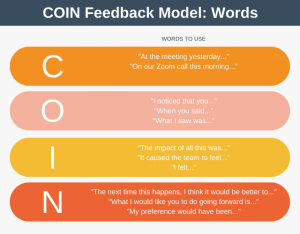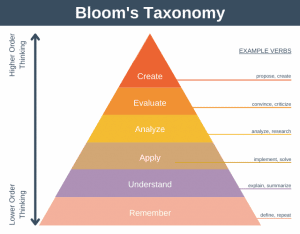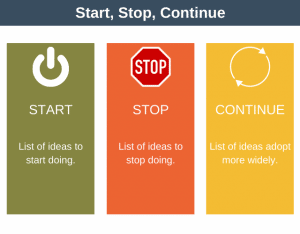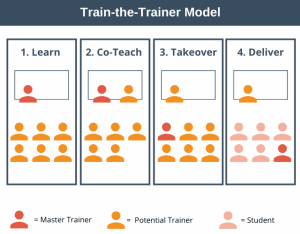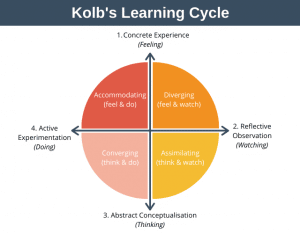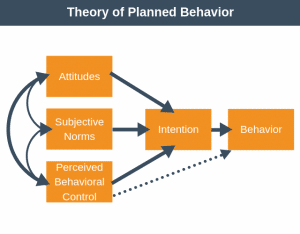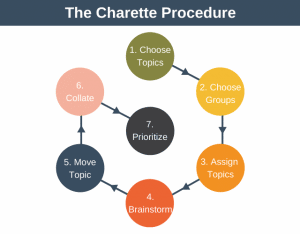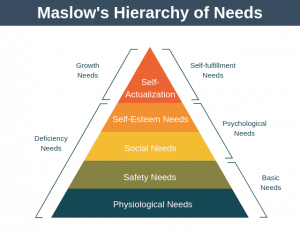We’ve all experienced a bad meeting. One where people arrive after the official start time and the meeting starts 15 minutes later than planned. There is no clear agenda so the meeting meanders around various topics. The person with the authority to make a decision isn’t present. At the end of the meeting, it’s overrun by 15 minutes and nothing is decided. Perhaps the only thing you’ve agreed is to hold another meeting! Clearly nobody is being guided by a set of effective meeting guidelines.
It’s easy to see why this occurs. When we first begin our careers we’re invited to attend meetings. Typically these meetings will be of the unstructured variety as described above, and we begin to think that this is simply how meetings are done. But it doesn’t have to be this way.
There are fortunately some effective meeting guidelines you can follow to ensure that your meetings are both productive and run like clockwork. A good way to think about these steps is in terms of what you need to do before the meeting, during the meeting, and after the meeting ends.
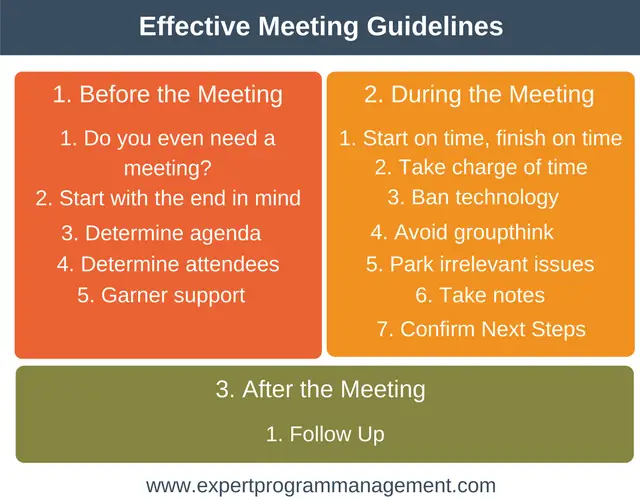
These effective meeting guidelines apply whether you are meeting face to face, or via teleconference or videoconference.
Before the Meeting
In order to setup your meeting for success, take these steps before the meeting begins.
1. Do You Even Need a Meeting?
Unnecessary meetings lead to frustration and waste time, so before you jump in and schedule your meeting, think if another means of communication might be more appropriate? Perhaps a simple email sent to 3 or 4 of the right people could achieve the same objective?
2. Start With The End in Mind
When you first think of calling a meeting, a good place to start is to identify the specific purpose of the meeting. Meetings can serve all kinds of purposes:
- To reach a decision
- To provide direction
- To generate ideas
- To inform people
- To create a plan
- To review status
- To create enthusiasm around an idea
One simple way to phrase this in your mind is “At the end of this meeting, we want to have…”.
Now that you know what you want the meeting to achieve, you’re in a position to determine what the agenda should be, and who needs to attend.
3. Determine the Agenda
Without a clear agenda it’s much more likely your meeting won’t be a success. In simple terms your agenda needs to list:
- The topics to be discussed.
- The time allocated to discuss each topic.
- Who will lead each agenda item.
Make sure you distribute you agenda to the attendees at least 24 hours before the start of the meeting so that everyone is given time to prepare. If it’s a regular meeting, such as a weekly team meeting, then create an agenda template that will be used each week.
4. Determine the Attendees
You’re going to need the right people in the room. It might sound obvious, but if you are calling a meeting to make a decision, then the meeting will be pointless unless the key decision maker is present.
Don’t go too far – to have the most effective meeting you should invite everyone who needs to be present, but not a single extra attendee. Once you have your list of attendees, review it to see if anyone can be removed.
With the advent of technology, meeting invites are often send by email. One problem this creates is that invites are forwarded by attendees to other people within the organization who may also be interested in attending. What started out as a focussed meeting with 6 attendees could soons become a 28 person meeting where nothing gets decided.
To avoid this check if extra people beyond your original list have been invited to attend. If additional people have been added then follow up to see what they will contribute to the meeting that the original attendee cannot.
5. Garner Support
The final one of our effective meeting guidelines to perform before the start of your meeting is applicable if the purpose of your meeting is to get support for an idea or plan of action that you are proposing. In this scenario it’s worth remembering that anything can happen in a group situation when people are presented with something new for the first time.
To maximize the chances of getting what you want it’s a good idea to speak to each attendee individually before the meeting. This allows you to check that their win conditions are being met and that they are happy with what you are proposing. It also affords you the opportunity to recalibrate your proposal based on their feedback before the meeting begins.
This approach takes a considerable amount of time, but it stacks the deck in favor of your proposal being approved.
During the Meeting
Now that we’ve laid the groundwork for having a successful meeting, let’s keep our momentum by running the meeting effectively using the following rules:
1. Start on Time, Finish on Time
People feel appreciated when you treat them and their time as valuable, so make a point of starting and finishing on time.
Through the simple act of building a reputation for starting and finishing on time, you’ll be amazed at the goodwill you’ll create, and the effort people will make to not only attend your meetings but to turn up on time.
2. Stick to Your Timings
Before the meeting you already created an agenda laying out how much time was devoted to each topic, now it’s time to stick to it.
It can be a good idea put the agenda up on a screen or whiteboard so as everyone can see it. If there are a lot of people present in the meeting, then it can be difficult to focus on what’s being said as well as manage the time, so consider asking a colleague to time keep.
3. Ban Technology
Quite simply it’s not going to be an effective meeting if people are using their phones or laptops during the meeting.
4. Avoid Groupthink
Groupthink occurs when everyone gets behind a consensus view, and is the enemy of creativity and imaginative idea generation. A very simply technique to avoid this is to ask senior members of staff to contribute to the discussion last, and the more introverted team members to contribute first.
5. Park Issues as Necessary
A useful tool to prevent getting sidetracked by interesting ideas that pop up during the meeting is to use the “parking” technique.
It works like this. When an interesting discussion topic is raised that doesn’t relate to the agenda, do the following:
- Thank the person for raising the point.
- Tell them that unfortunately the point they’re raised is a little bit outside of the scope of the meeting.
- Tell them that you’ll make reference to the point they’ve raised in the meeting minutes.
- Tell them we can then choose whether or not to organize a follow-up to discuss this point.
Using this technique acknowledges and respects people’s contribution to the meeting, but ensures your meeting stays on track, discussing only the topics raised in the agenda.
6. Take Notes
It’s amazing how many meetings happen without anyone taking notes! The reason to take notes is to record any questions raised, any decisions made, and any actions assigned.
We’ll later use these notes as the basis for sending the meeting minutes.
It can be a good idea to project on screen the document you are using to collect the notes. This way you create consensus around the minutes and nothing gets missed. If you’re not able to do this, then use a pen and paper to collect the notes and not a laptop or similar device, otherwise people may think you’re being rude by using your computer mid meeting.
If the meeting has a particularly large number of attendees then consider asking a colleague to collect the notes on your behalf, as it can be difficult to concentrate on what’s being said, keep the meeting on track, and take notes!
7. Confirm Next Steps
The final step of our effective meeting guidelines to use during the meeting is to always leave the last few minutes of your meeting to review the next steps, including who is responsible for each step and any deadline associated with that step.
This solidifies in everyone’s mind that the meeting has been a success, and ensures no actions get left without an owner or deadline.
If all the actions belong to a single person then ask the others in the room if there are any actions they would be able to take off that person’s hands.
After The Meeting
Now that you’ve just finished a fantastic and productive meeting, there is just one step remaining.
1. Follow Up
We each interpret the world in different ways. Thus, it can be quite common for different people present in the meeting to come away with a slightly different understanding of what was agreed.
To avoid this, tidy up the minutes you took during the meeting and distribute them to all attendees and any other interested parties. Do this promptly after the meeting finishes.
The most important part of the minutes is WWDWBW – which is an aycronym meaning Who Will Do What By When?
Meeting Agenda Template
The basis of these effective meeting guidelines is to establish a solid agenda. A simple Meeting Agenda Template is shown below that you can use and modify to create your own meeting agendas.
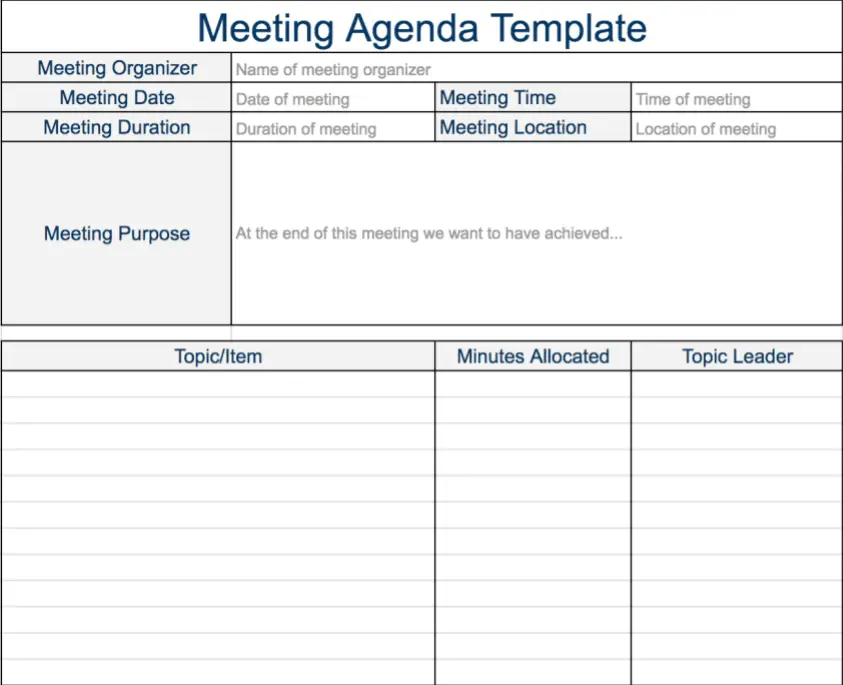
Effective Meeting Guidelines Summary
Without effective meeting guidelines, meetings can very easily descend into a waste of time if you’re not careful. It’s hard to imagine a single person exists in the world who in a professional corporate capacity hasn’t experienced a pointless meeting.
All great meetings begin before the meeting when the purpose of the meeting and the agenda are developed. During the meeting care needs to be taken to keep the meeting on track and productive. Finally, after the meeting it is important to distribute the minutes including WWDWBW – Who Will Do What By When.
If you follow these effective meeting guidelines then you should be able to increase significantly the quality of your next meeting.
